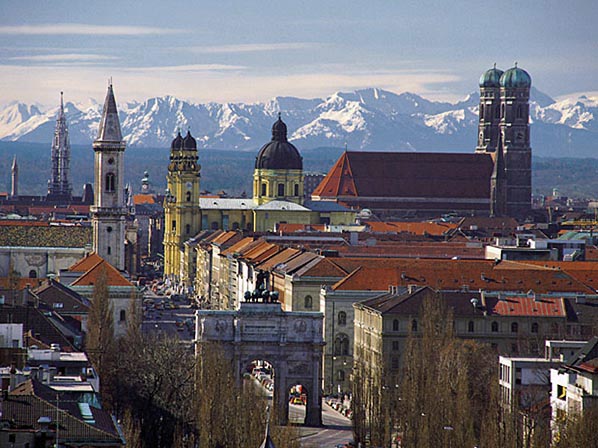
München's Wahrzeichen when the Föhn blows
The Leopoldstrasse with Siegestor, Theatinerkirche, Frauenkirche,
and the chain of the Alps a hundred kilometers to the South
Ballrooms
for Angels
Southern
German Baroque Churches
München and Oberbayern
Google-Map

München's
Wahrzeichen when the Föhn blows
The Leopoldstrasse with
Siegestor, Theatinerkirche, Frauenkirche,
and the chain of the
Alps a hundred kilometers to the South
München boasts a wealth of museums, beautiful buildings, and popular beer gardens, but it can offer only three truly Bavarian Baroque churches: St. Anna-im-Lehel, St. Michael-Berg-am Laim, and the Asamkirche on Sendlinger-Strasse. All other prominent Baroque churches were built by Italian and French architects who were hired by the Baviaran Kings. The real Bavarian Baroque hides in the villages and the rural country side.
Theatinerkirche St. Kajetan, 1663-1690
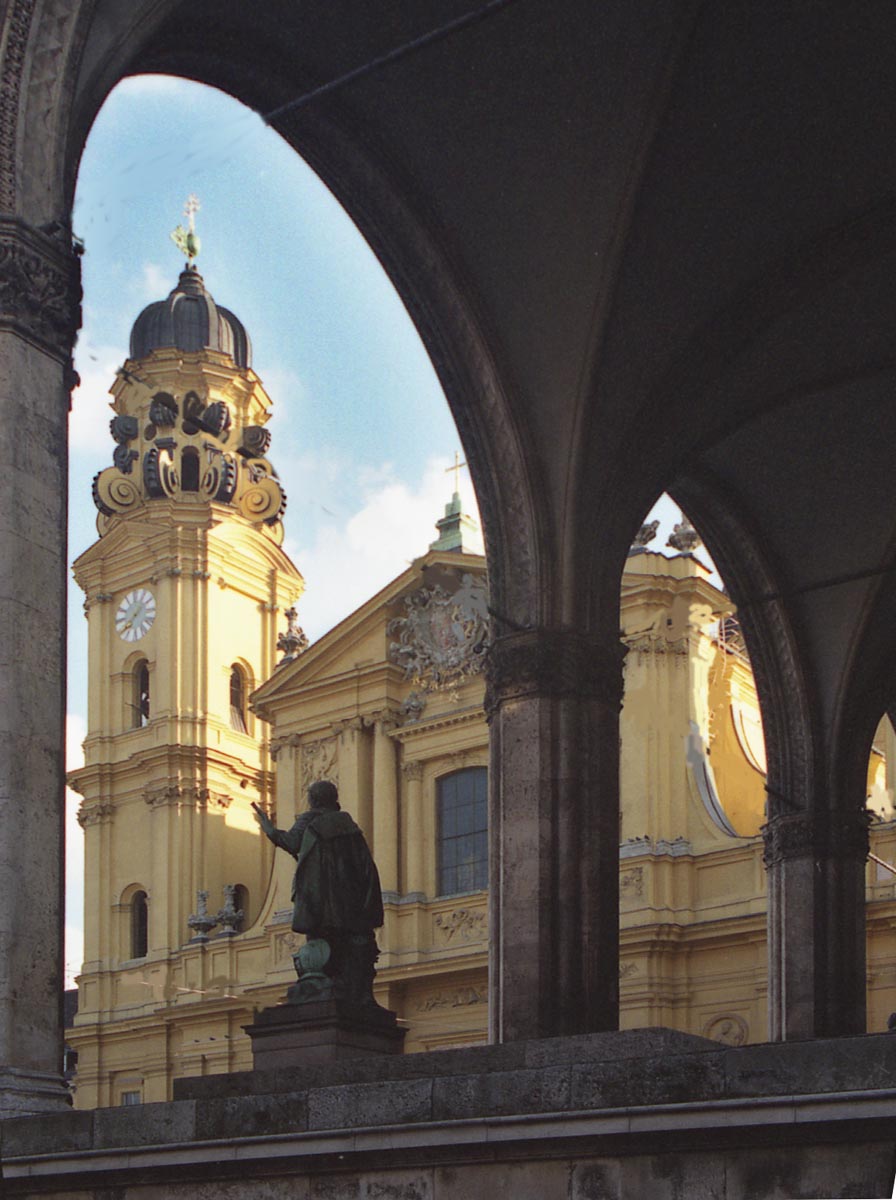
Theatinerkirche
St. Kajetan seen from the Feldherren Halle
Built in high Italian Baroque style, inspired by Sant'Andrea della Valle in Rome, by the Italian architect Agostino Barelli. His successor, Enrico Zuccalli, added two towers, originally not planned, and then finished the 71 meter high dome in 1690. The facade was completed only in 1768 by François de Cuvilliés.
St. Anna-im-Lehel, 1727-1733
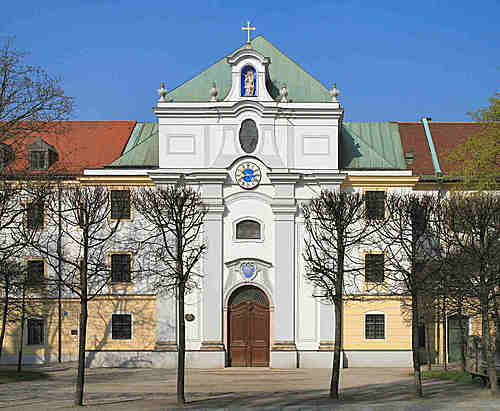
The unpretentious facade of the church
The lovely church of St. Anna was built by Johann Michael Fischer. The interior decoration by Egid Quirin Asam and Joh. Baptist Straub was finished 1737. This is the earliest example of Fischer trying to solve the crossing of main and cross nave: a for Bavaria novel cruciform floor plan covered by a single, large oval dome.
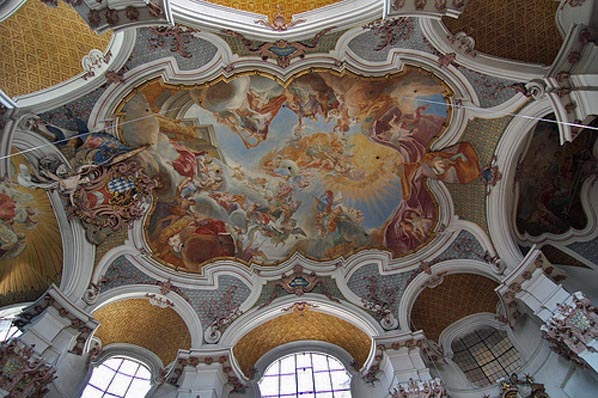
The
reconstructed ceiling
The church was completely destroyed by the Allied air raids in 1944. Rebuilt from the old plans the reconstruction was crowned by a painstaking, two-year repainting of the ceiling fresco by the Munich painter Erwin Schleich in 1979. The old front resembled that of the Asamkirche, it has been rebuilt in the form shown on the photo
St. Michael in Berg am Laim, 1738-1751
In a suburb of Munich Johann Michael Fischer built a Court Church for Fürstbishof Clemens August of Cologne. Although it is an important development point in Fischer's career, it is to me architecturaly the least exciting of the three Baroque churches in Munich .

Altar
of St Michael-Berg-am-Laim
The splendid stucco decoration and the frescoes are the work of Johann Baptist Zimmermann (1743), the altars are by Johann Baptist Straub, and the gilded figures on either side of the tabernacle are a contribution of Ignaz Günther.
Asamkirche of St. Johann Nepomuk, 1733-1746

The cheerfully renovated Sendlingertor Strasse facade of the Asamkirche (2006)
The Baroque facade of the last church of the Asam Brothers blends into the houses of the Sendlingertor-Strasse in central Munich. It is flanked by the priests' house and the house Cosmas Damian Asam built for himself. It is the one major late Baroque church in the city of Munich.
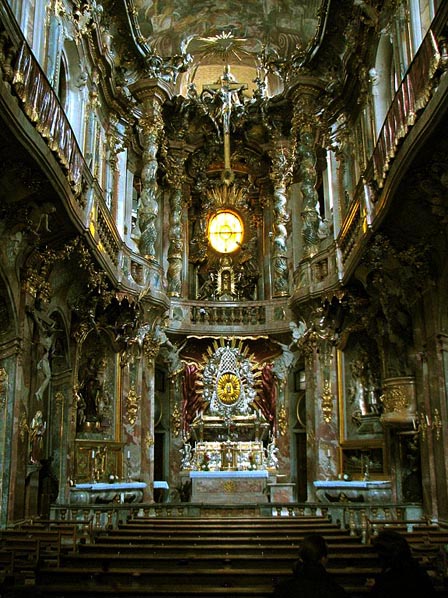
The
nave and the reconstructed altar of the Asamkirche (2006)
The church is a dark, mystical cave. The only light comes from the
windows behind the altar. Curious tropical tendrils in gold and brown
overgrow the walls. Two Bernini-derived spiral columns frame and hold
a fantastic, three-story altar. God Father himself looks down from
its topmost tier, Christ on the cross seems to float freely, and the
Holy Ghost appears as a pigeon - a mystical Trinity, which only Egid
Quirid Asam could have conceived of.
In 1944 an Allied bomb
destroyed the eastern wall of the nave. It has been reconstructed
twice. The photo shows the altar after the last renovation (2006), in
which a sculpture of St. Nepomuk and a blind wall behind him was
removed to let more light into the nave by restoring the large, round
window of the original building.
Freising, Dom St. Maria and St. Korbinian 1160-1205, Baroque: 1723-24

Freising is the old, ecclesiastical capital of Bavaria north of Munich was the seat of a Bishop since 739. It rises on a hill above the moors. Surrounded by narrow streets stands the mighty Romanesque Dom. The Baroque produced an exquisitely integrated "coating" of its three naves. The sparing stucco and frescoes are by Egid Quirin Asam (1723-24).
|
|
|
Kloster Andechs 1520-58 – Baroque interior around 1750
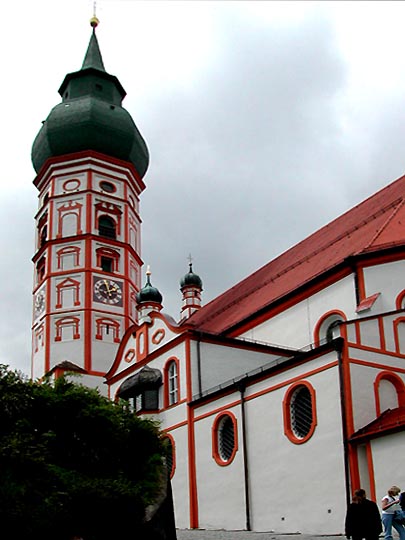
Pilgrimage church of Kloster Andechs 1520-58
The Holy Mountain of Bavaria an hour south of Munich has for decades been the first and last place we visited when we were in Bavaria... A long hike from Herrsching to this beautiful church, crowded with colorful pilgrims on weekends- not to mention the dangerous, dark beer the monks brew and their Romadur cheese. A true Bavarian experience.
The Herren of Andechs had once great political influence in the 11-13th cent, especially through their daughters. Two Andechs women, Hedwig of Silesia and Elisabeth of Thuringia became saints and are still highly revered to this very day. However, in 1208 Andechs was accused of involvement in the murder of King Philip von Schwaben in Bamberg. A pretext the Wittelsbacher used to destroy the castle. According to legend the relics of the church were hidden. They resurfaced in the 15th cent founding a flowering pilgrimage to this Holy Mountain.
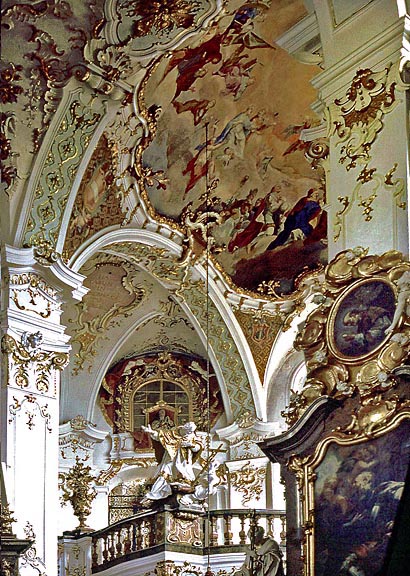
The Baroque interior
The Gothic Pilgrimage Church was modified during the Counter-Reformation (1712-51) into a most exuberant Baroque interior : stucco, paintings, and altar are by Joh. Baptist Zimmermann (note his signature reseda-green!) and Joh. Georg Ueblherr, his brother-in-law.
|
|
|
There is a large collection of unique votive candles and an epitaph to the composer Karl Orff in a side chapel where he is buried. From the entrance hall leads a staircase into the tower with a superb view of the Alpes.
Kloster Diessen 1732-39
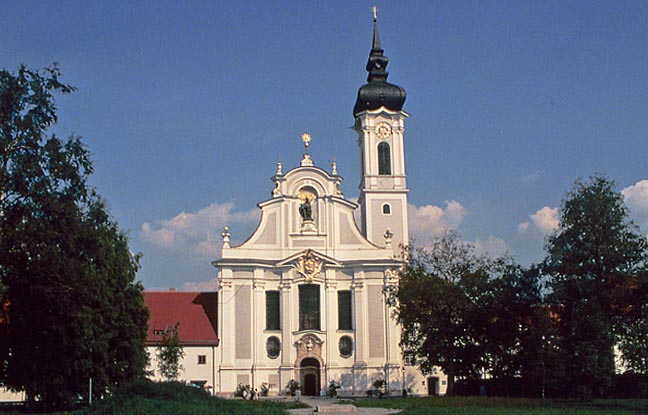
Former Augustinian monastery Church St. Maria (1732-39) by Joh. Michael Fischer. Facade and nave relatively conservative "Vorarlberger scheme": the nave subdivided by square wall pilasters.
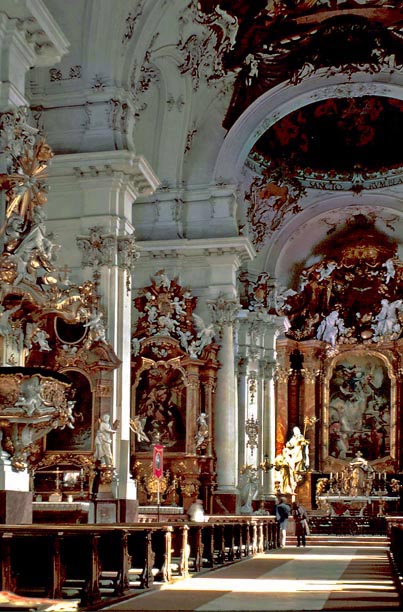
Dietramszell
1729-48
Former
Augustinian Monastery Church
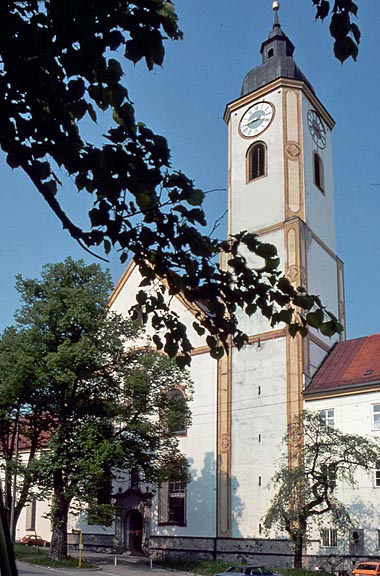
Easily
overlooked, the modest facade hides a most beautiful interior
my
orange BMW is parked in front of the Apotheke!
Since the Secularization (1803/30) the
monastery has been occupied by Salesian nuns from Indersdorf. The
architect is not known (Joh. Michael Fischer?) but the restrained
stucco and frescoes (1744), and the main altar (1745) are by Joh.
Baptist Zimmermann.
In the side chapels are a number of
exceptional painted sculptures by Franz
Xaver Schmädl and others.
|
|
|
Dietramszell appears only in the German architectural guides. I discovered it for myself one day in 1972, and since then the blue drapery behind the altar has left a hole in my retina. It became more meaningful than all other Baroque interiors to me – and Susanne dreamt for years of getting married there....
The Wies 1739-54
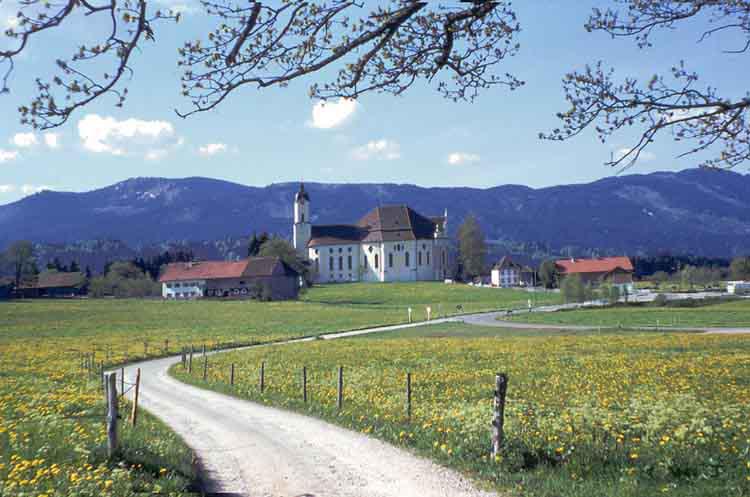
Pilgrimage
Church on the Wies, Dominikus
Zimmermann
The church stands in a meadow (German: "Wies") in the woods. The jewel of the Bavarian Baroque - a precious tabernacle for a miracle-working, trouvé sculpture of a "Schmerzensmann", a blood-stained image of the suffering Christ. In 1738, tears were seen on the dilapidated wooden figure of the Scourged Saviour.
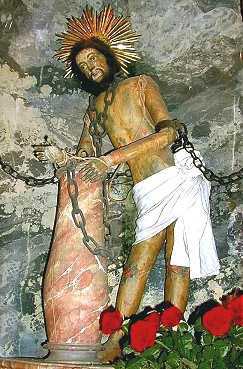
This miracle resulted in a pilgrimage rush to see the sculpture. In
1740, a small chapel was built to house the statue but it was soon
realized that the building would be too small for the number of
pilgrims it attracted, and so Steingaden Abbey decided to commission
Dominikus Zimmermann to build a separate shrine.
Construction took
place between 1745 and 1754, and the interior was decorated with
frescoes and stuccowork in the tradition of the Wessobrunner School.
"Everything was done to make the supernatural visible. Sculpture
and murals combined to unleash the divine in visible form".
It became the last church of Dominikus
Zimmermann, who built himself a house next to the church to spend
his final 12 years. He died in 1766. The sublime quality of the
church's interior has to be seen. An abbot left a sgrafitti
incription in one of the glass windows, incised with his diamond
ring, which describes the spirit of place: “In hoc
loco habitat fortuna, hic quiescit cor.”
Despite
bus loads of tourists the Wies still retains its magic
ambiance.
Non-Bavarian visitors to the Wies often see nothing with
their inner eye and complain of the "fakeness" of
Zimmermann's architectural elements: The wooden(!) columns are
covered with colored stucco which looks like marble - but isn't
marble. Marble of the desired color simply doesn't exist. The
sculptures are likewise from stucco not wood - but they are
sophisticated, often arrogant plaster figures in their own right. His
interiors may be trompe l'oeil, but they are so raffiné that
to call them "Kitsch" would be a sacrilege.
Leave your car somewhere a few kilometers away from the mass tourists, e.g., near Steingaden - an easy 1-hr hike on boards across the moors - and walk.
|
|
|
|
|
|
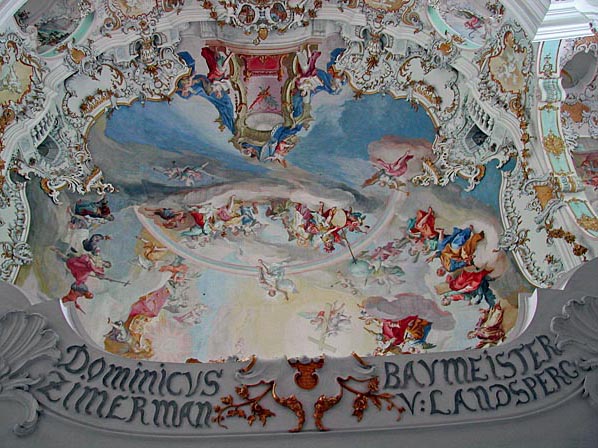
“Dominikus Zimerman Baumeister von Landsperg” the architect's signature over the entrance
For a 360-deg architectural video go to Williams College.edu
Rottenbuch
1085-1125, Baroque:1737-46
Former church of an
Augustine Monastery (1085-1125)
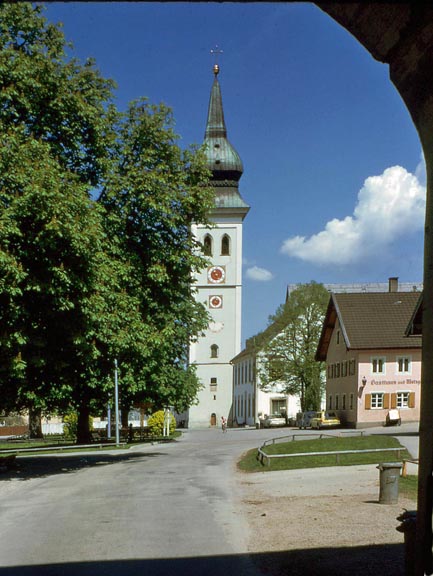
Abbey
Church Rottenbuch since the secularisation parish church
The design of a crossing transept and free-standing Romanesque tower (its helmet is Baroque) is unusual for Bavaria. Rottenbuch was a center of papal loyalty during the Investiture Controversy. In the 14th century, with its location on the pilgrimage route to Italy, Rottenbuch became the most influential house of Canons Regular in Germany. Their library was destroyed with the monastery by the secularization of 1803. Wikipedia
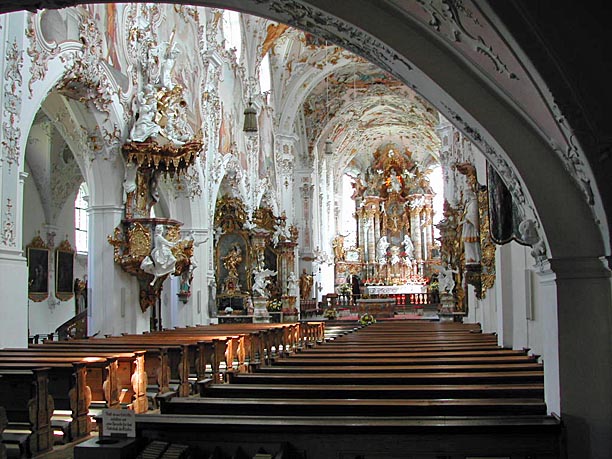
The church is a felicitous example of an exuberant Baroque encrustation (1737-46) applied onto an existing Romanesque barrel vault. The stucco was created by Joseph Schmuzer, the paintings by Matthäus Günther: full of music and innumerable puttos playing instruments
|
|
|
|
|
|
Kloster Ettal 1710-52
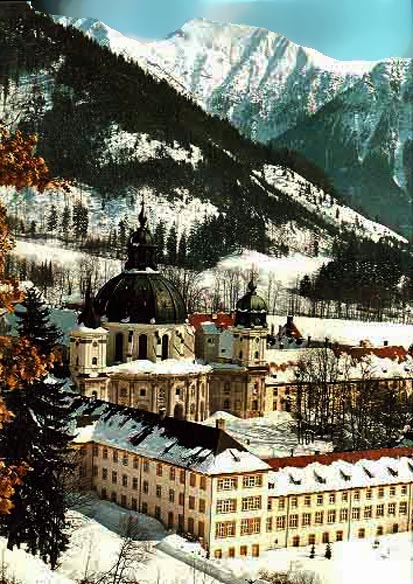
Benedictine Monastery and Church (1710-52) by the Tyrolian architect
Josef Enrico
Zucalli on an earlier building. Johann Schmuzer finished
Zucalli's design and the interior after a fire in 1744.
Zucalli
raised the Baroque church on the foundations of an unusual circular,
Gothic "tabernacle" bulding (1330) designed for the
services of a Holy-Grail-Knights' Academy, modeled on
St-Michel-d'Entraigues and the English Chapter Houses of Salisbury
and York. A detailed description of the history of the building can
be found in the ambulatory of the church.
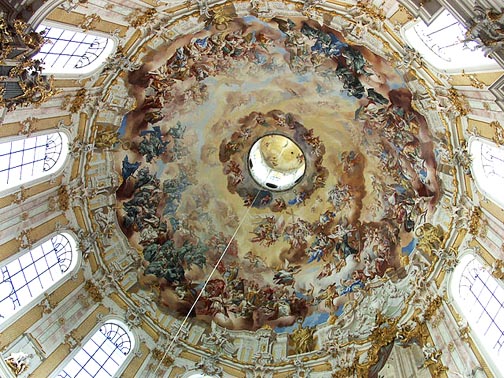
The interior is a superb marriage of the unusual Gothic architectural concept with Baroque forms under a large copula. The Gothic space had a central support column! The minimal stucco by Johann Schmuzer (Wessobrunn). The organ empore is by Joh. Baptist Zimmermann. The classicistic main altar by Martin Knoller, the copula fresco by Johann Jakob Zeiller, both like Zucalli from the Tyrol.
Kloster
Benediktbeuren
Anastasia Chapel 1750–1758
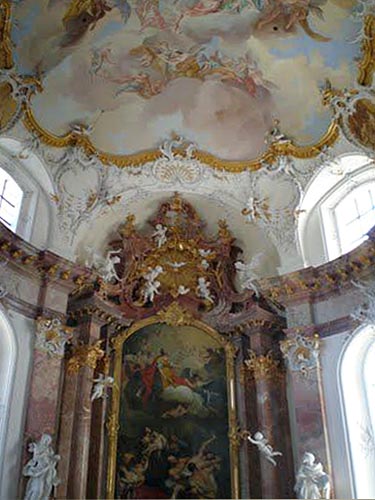
Anastasia Chapel in the Church of St. Benedikt (1750–1758).
One of Michael Fischer's last commissions, a jewel of Baroque
architecture
For many years I searched for photos and a
description of this chapel. Now I came upone an entry in the German
Wikipedia; not the greatest text but the dates and details I was
looking for.
The design of the chapel is by Johann
Michael Fischer, the decorations as well as the main Altar are by
Johann
Michael Feuchtmayer. The sidealtars are the work of Ignaz
Günther and the ceiling fresco of the Trinity was painted by
Johann
Jakob Zeiller.
Rott am
Inn 1759-60
Michael Fischer's Testament
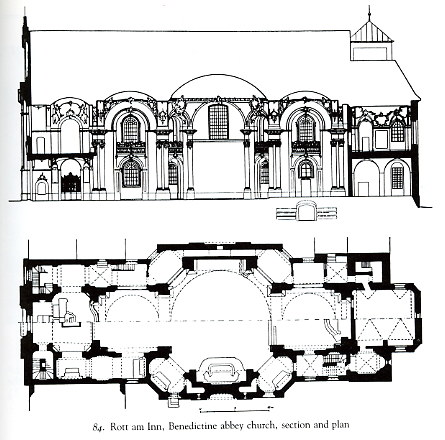
Plan of St. Marinus and Anianus (1759-60). The last great church by Johann Michael Fischer, formerly a Benedictine Monastery
Space and the means of the client forced Fischer into a design of
intimate concentration. He decided to divide the "Langhaus"
into 3 square spaces and integrate them and the rudimentary
cross-nave by circular copulas ontop each of the cubes - a separate
choir served the monks - The stucco is sparse, exposing the
architecture. The paintings except the ceiling are held in a cool
gray off-white. The result is of a distant, quiet elegance. One feels
the beginning of Classicism.
Still, if one compares Rott to the
dynamic architecture of Neumann in Neresheim, this is a mature but
conservative design, not an experimental building. Fischer remained
faithful to his end to his background as a sober "Baumeister".
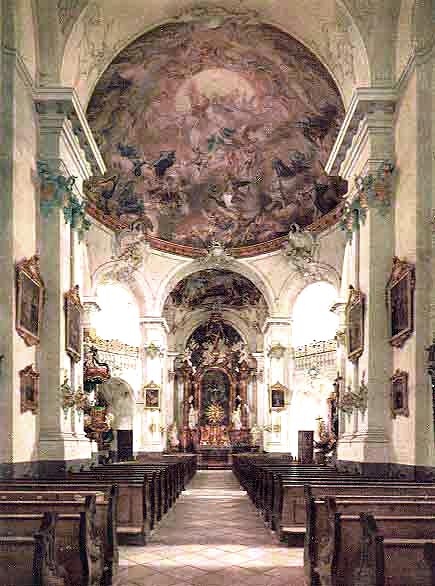
The
nave
The sparse stucco, altars, frescoes and the painted sculptures on the side altar right next to the entrance are among the best work of Ignaz Günther (1763). Text: Wikipedia, Photos: flickeflu
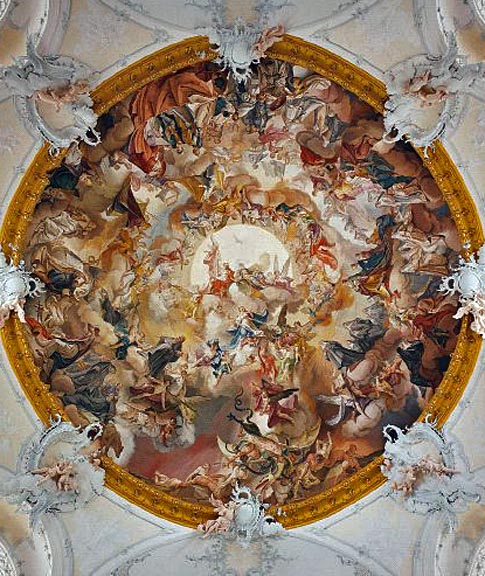
Ignaz
Günther's ceiling fresco in the dome of the quadrature
For a 360-deg architectural video go to Williams College.edu
One should see Rott in Winter when the cold light reflected from the snow lights every space - here Mozart's Quartett No. 16 in Es-Dur, KV 428 fills the mood